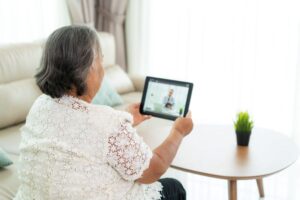
There’s a quiet sort of magic that happens when someone remembers your name, calls just to say hi, or sends a card because they saw something that reminded them of you. It’s not extravagant. It’s not groundbreaking. But it is real, and it matters more than we sometimes like to admit. Human connection isn’t just about passing time—it’s about feeling seen. For many people, especially in the second half of life, that kind of connection can get harder to come by. Kids grow up, neighbors move, and the pace of life slows, which can make the silence feel louder. But here’s the thing: connection isn’t a luxury. It’s a lifeline.
You don’t have to be surrounded by a dozen people every day to feel connected. What you do need are a few relationships that feel real, mutual, and consistent. Whether it’s a longtime friend or someone new, that spark of shared experience and understanding does something good to the soul. It keeps us from feeling invisible. And nobody, no matter how independent or introverted, truly thrives in isolation.
Why It’s Easy to Drift and How to Pull Back In
Life has a sneaky way of getting in the way. One day you’re juggling work, family, house stuff—and then suddenly, you blink and realize it’s been months or years since you had a long conversation with someone who really knows you. That drift happens quietly. You don’t notice it until you do. But the good news is, reconnecting doesn’t have to be dramatic or awkward. A small step goes a long way. You don’t need a grand reunion or a long apology. A quick message, a phone call, even a funny article forwarded with a “this reminded me of you” can re-open a line that’s been quiet for too long.
If you’ve moved to a new place or are simply feeling like your social circle’s gotten smaller, there are plenty of ways to meet new friends that don’t involve loud events or big commitments. Local libraries often host book clubs or talks. Coffee shops sometimes post community events on their boards. Volunteering is another smart way to ease into new friendships—when you work on something meaningful with other people, conversation happens more naturally. You’re not trying to “network.” You’re just being yourself, doing something useful, and letting relationships unfold at their own pace.
Reach Back, Not Just Out
Sometimes the best connections aren’t new. They’re old ones waiting to be dusted off. Getting back in touch with people you once knew—especially those you went to school with—can be surprisingly meaningful. It’s not just about reminiscing or rehashing prom stories. It’s about anchoring yourself in people who remember parts of you that most others don’t.
These shared histories are powerful. Someone who knew you in your teens or twenties brings a kind of context that new friends can’t. Even if you haven’t spoken in decades, there’s often a shortcut to comfort when you reconnect. It’s not about comparing life paths. It’s about remembering that you weren’t alone in growing up.
For example, the website Classmates makes it easy to look up old schoolmates, even if you only vaguely remember names or haven’t kept yearbooks. You don’t need to dive into every detail of your past or share everything about your present. Sometimes a simple “Hey, I found you on here—remember our history teacher’s bad breath?” is enough to reopen the door. Not every reconnection leads to a lifelong friendship, but even one good reconnection can remind you that your past still matters, and so do you.
Let Technology Be Your Wingman
Technology can feel overwhelming, especially when every app wants your email, phone number, and a blood sample just to log in. But once you get past the setup headaches, it’s worth it. Video calls, group texts, online classes—these tools aren’t just for teenagers. They’re lifelines for people who can’t always be physically close to others but still want to stay emotionally close.
You don’t have to be a tech expert to benefit from it. FaceTime, Zoom, WhatsApp—they all have one job: keeping people in touch. That’s it. You don’t have to post your life story or download seventeen apps. You just need to pick the one or two that make sense to you, and use them consistently.
If you’re feeling brave, group chats with grandkids can be a sweet way to stay part of their daily rhythm. Even if they reply with one-word answers or memes you don’t understand, you’re showing up. And that means something. If your comfort zone stops at email, that’s still a connection. You’re not “behind.” You’re human.
Connection Isn’t Always Loud
There’s a common misconception that social people are the ones with packed calendars, constant chatter, and a million friends. That’s not true for most people, and it doesn’t need to be. Connection doesn’t always look like parties or crowded tables. Sometimes, it’s the consistency of a weekly phone call. The familiarity of a neighbor’s wave. The quiet ritual of exchanging holiday cards every year, even when nothing else gets said.
The real power of connection lives in being remembered and valued. Not everyone wants or needs a big social life, but everyone needs to feel like they matter to someone else. That kind of reassurance can come in small doses. You don’t need constant company—you just need a few people who think of you, reach out, and let you do the same for them.
It’s also okay to outgrow some connections. Not every relationship is meant to last forever, and forcing closeness with someone who drains you isn’t noble—it’s exhausting. The key is to stay open. To say yes more than you say no. To take the risk of reaching out first. That’s where the good stuff starts.
A Quiet But Mighty Thing
Human connection doesn’t always come with fireworks or grand gestures. Most of the time, it shows up in the quiet corners of life. A shared laugh, a thoughtful message, a remembered birthday. Those moments string together like lights, soft but steady, keeping the darkness at bay. You don’t need a huge circle. Just a few strong ties can change the way your days feel. You start noticing how much easier it is to get through hard stuff when someone’s there, even just on the other end of a phone.
So if you’ve been meaning to call someone, do it. If you’ve been thinking about joining something, try it. The longer you wait, the harder it gets—but the flip side is true, too. The sooner you reach out, the faster something good can grow.
Because we don’t stop needing people just because we’ve gotten older. If anything, we need them more.








